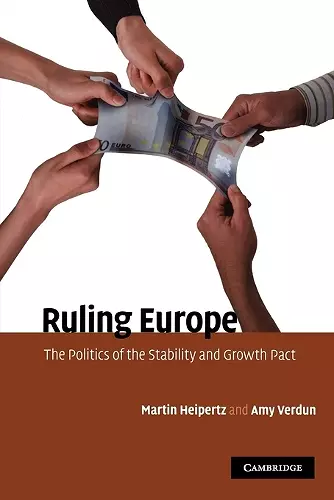Ruling Europe
The Politics of the Stability and Growth Pact
Amy Verdun author Martin Heipertz author
Format:Paperback
Publisher:Cambridge University Press
Published:3rd Feb '11
Currently unavailable, and unfortunately no date known when it will be back
This paperback is available in another edition too:
- Hardback£90.00(9780521197502)

This book analyses the fraught history and politics of the Stability and Growth Pact from its origins to the present economic crisis.
One cannot understand the euro without understanding the Stability and Growth Pact. The SGP is central to Economic and Monetary Union in Europe since it regulates the fiscal policies of EU Member States. This book analyses the fraught history and politics of the SGP from its origins to the present.The Stability and Growth Pact (SGP) is central to Economic and Monetary Union (EMU) in Europe. Initiated by Germany in 1995 and adopted in 1997, it regulates the fiscal policies of European Union Member States. Following numerous violations of its deficit reference value, the Pact's Excessive Deficit Procedure was suspended in 2003. The decision to suspend was brought before the European Court of Justice in 2004 and the SGP then underwent painstaking reform in 2005. After a period of economic prosperity and falling budgetary deficits, the global economic crisis put the system under renewed stress. Ruling Europe presents a comprehensive analysis of the political history of the SGP as the cornerstone of EMU. It examines the SGP through different theoretical lenses, offering a fascinating study of European integration and institutional design. One cannot understand the Euro without first understanding the SGP.
Review of the hardback: 'This is a major and timely study of a central issue area in European integration that goes to the very heart of the complex relations between the EU and its Member States, namely fiscal policies. The authors make effective use of European integration theories to elucidate and explain how these relations have evolved in the context of Economic and Monetary Union. The result is a book that is essential reading for all students of European integration and especially for those working in political economy.' Kenneth Dyson, School of European Studies, Cardiff University
Review of the hardback: 'The consolidation of public finances has always been a pertinent issue. This challenge is getting even larger due to the financial crisis and the considerable public funds that had to be provided for the stabilisation of the financial system. Governments have to reduce their deficits in order to regain the capacity to act and central banks have to collect the liquidity that they provided in avoiding a systemic crisis. The Stability and Growth Pact represents the principle of sustainability for fiscal policy in Europe. It is therefore more important than ever before, and I welcome that this book provides the first, comprehensive account of the history of the creation, implementation and reform of the Pact.' Theodor Waigel, former German Minister of Finance
Review of the hardback: 'This book is a remarkable history of the European debate on the role of fiscal constraints in the construction of the European Monetary Union. It is also a deft application of paradigms used by political scientists, demonstrating that they are not rivals but are indeed complementary.' Peter B. Kenen, Walker Professor of Economics and International Finance Emeritus, Princeton University
Review of the hardback: 'Economic and Monetary Union, at its tenth anniversary, is without any doubt one of the most important achievements of European integration. Its continued success rests on two cornerstones: independence of the European Central Bank - with a clear mandate to safeguard price stability - and sustainability of public finances. The Stability and Growth Pact was conceived to provide the appropriate framework for coordinating national fiscal policies in the EU. However, fiscal sustainability requires discipline and fiscal discipline requires political will and, indeed, courage. The Stability Pact is a framework and not a substitute for that courage. Its political history, as described in this book, teaches us that good rules require good implementation. Economic and Monetary Union is now challenged by the most severe economic and financial crisis in the post-war era. It is of utmost importance that Member States live up to the spirit of the Stability and Growth Pact and regain the path towards sound, sustainable public finances as soon as possible.' Jürgen Stark, Member of the Executive Board of the European Central Bank
Review of the hardback: 'For the general reader, this book presents a fascinating account of the rise, failure and transformation of fiscal coordination among the member states of the European Monetary Union. Political scientists, on their part, ought to be impressed by the methodological sophistication of the authors who are able to integrate four different theoretical perspectives to achieve more complete explanations of highly complex decision processes.' Fritz W. Scharpf, Max Planck Institute for the Study of Societies
Review of the hardback: '… a fascinating and critical account of the interplay of the different forces that shaped the Stability and Growth Pact and its implementation. This book explains how politics never forget the national interest when building Europe, the importance of the economic calculus by experts as well as the intricacies of the European bureaucracy … a fresh look at the Stability and Growth Pact.' Filip Keereman, Head of Unit Monitoring of National Financial Developments and External Funding, European Commission
'… an informative, detailed and readable case study of the SGP … likely to appeal to policy practitioners and readers with a general interest in understanding the making and development of the pact. It also provides a valuable reference source for academics who want to learn about the details of the SGP's history.' Patricia Wruuck, University of Mannheim
ISBN: 9780521283304
Dimensions: 229mm x 152mm x 19mm
Weight: 490g
334 pages